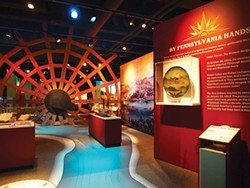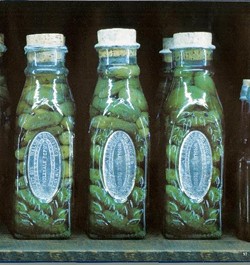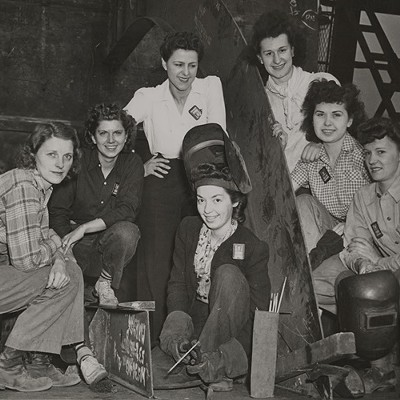Tuesday, January 6, 2015
Final Week for Pittsburgh’s Lost Steamboat at the History Center
It struck me some hours after I’d seen this exhibit what felt so tellingly odd about it.
Most displays of historical artifacts are notable because of who owned or used them: Lincoln’s hat, the Iceman’s copper axe. What’s striking about the large array of items in Pittsburgh’s Lost Steamboat: Treasures of the Arabia is that the vast majority of it had never been used at all.
The exhibit, which closes this Sunday, is the result of the excavation of a Pittsburgh-built steamboat that sank in the Missouri River in 1856.
All 200 tons of this stuff — woolen flannel trousers, soap, handsaws, bottled cherries, shoes, ceramic dinner plates, lumber, cigars, leather boots, coffee grinders — was bound to merchants on what was then the Western frontier: Kansas, Nebraska, Iowa. (The exhibit includes about 2,000 items, a fraction of what was unearthed from beneath a Kansas cornfield.) Before the rise of transcontinental railroads, steamboats were the only way to get so much merchandise out there.
So these porcelain doorknobs, long dark woolen socks (men’s and women’s) and glass jars of pickles sat entombed beneath silt while still inhabiting a sort of retail limbo between manufacturer and merchant.
Only in the United States, perhaps, would we conceive of “the frontier” as a place where you could have purchased mass-produced goods at established mercantile outlets. Some of the woolen shirts salvaged (one of which is on display) had a cloth heart stitched on the chest, which exhibit organizers speculate was intended for sale to the pro-slavery forces on the frontier, who embraced such symbols. These were the team jersies of their day (though the stakes, five years before the Civil War began, were rather higher than Steelers-Ravens).
On another level, there’s a weird metaphysical lightness about this assemblage of objects, unearthed still in their packaging, as it were. They're items of daily, even intimate use, yet at the same time completely impersonal.
A society of such material abundance that it could afford to lose so many hand- and machine-made goods and still function might have been unthinkable only a few generations earlier.
That feeling of our contemporary consumer society in embryo is driven home (likely unintentionally) by the way some of the shoes, tools and hardware are displayed, on long shelves like you’d find in a modern retail outlet, in cases with mirrored sides that make the arrays look infinite. And now some of these demonstrably disposable consumer goods are kept in climate-controlled cases, treated as carefully as pharoah’s mummy.
This was the era of steam power — a time of triumphantly ramping up dependence on the fossil fuels whose burning has now bequeathed us climate change. Yet even the mightly steamboats themselves were effectively disposable: The average one, the exhibit tells us, lasted five years before sinking. The Arabia lasted all of three. All of which suggests how much money there was to be made shipping condiment jars and lice combs to the folks who were busy forcing indigenous farmers and hunter-gatherers off their ancestral lands (an aspect of things on which this exhibit only glances).
For an alternate take, here's CP critic Charles Rosenblum's review of the exhibit.
The Heinz History Center is open 10 a.m.-5 p.m. daily. Admission is $6-15 and free for kids under age 5.
Most displays of historical artifacts are notable because of who owned or used them: Lincoln’s hat, the Iceman’s copper axe. What’s striking about the large array of items in Pittsburgh’s Lost Steamboat: Treasures of the Arabia is that the vast majority of it had never been used at all.
The exhibit, which closes this Sunday, is the result of the excavation of a Pittsburgh-built steamboat that sank in the Missouri River in 1856.
All 200 tons of this stuff — woolen flannel trousers, soap, handsaws, bottled cherries, shoes, ceramic dinner plates, lumber, cigars, leather boots, coffee grinders — was bound to merchants on what was then the Western frontier: Kansas, Nebraska, Iowa. (The exhibit includes about 2,000 items, a fraction of what was unearthed from beneath a Kansas cornfield.) Before the rise of transcontinental railroads, steamboats were the only way to get so much merchandise out there.
So these porcelain doorknobs, long dark woolen socks (men’s and women’s) and glass jars of pickles sat entombed beneath silt while still inhabiting a sort of retail limbo between manufacturer and merchant.
Only in the United States, perhaps, would we conceive of “the frontier” as a place where you could have purchased mass-produced goods at established mercantile outlets. Some of the woolen shirts salvaged (one of which is on display) had a cloth heart stitched on the chest, which exhibit organizers speculate was intended for sale to the pro-slavery forces on the frontier, who embraced such symbols. These were the team jersies of their day (though the stakes, five years before the Civil War began, were rather higher than Steelers-Ravens).
On another level, there’s a weird metaphysical lightness about this assemblage of objects, unearthed still in their packaging, as it were. They're items of daily, even intimate use, yet at the same time completely impersonal.
A society of such material abundance that it could afford to lose so many hand- and machine-made goods and still function might have been unthinkable only a few generations earlier.
That feeling of our contemporary consumer society in embryo is driven home (likely unintentionally) by the way some of the shoes, tools and hardware are displayed, on long shelves like you’d find in a modern retail outlet, in cases with mirrored sides that make the arrays look infinite. And now some of these demonstrably disposable consumer goods are kept in climate-controlled cases, treated as carefully as pharoah’s mummy.
This was the era of steam power — a time of triumphantly ramping up dependence on the fossil fuels whose burning has now bequeathed us climate change. Yet even the mightly steamboats themselves were effectively disposable: The average one, the exhibit tells us, lasted five years before sinking. The Arabia lasted all of three. All of which suggests how much money there was to be made shipping condiment jars and lice combs to the folks who were busy forcing indigenous farmers and hunter-gatherers off their ancestral lands (an aspect of things on which this exhibit only glances).
For an alternate take, here's CP critic Charles Rosenblum's review of the exhibit.
The Heinz History Center is open 10 a.m.-5 p.m. daily. Admission is $6-15 and free for kids under age 5.
Tags: Pittsburgh's Lost Steamboat: Treasures of the Arabia , Heinz History Center , Image

















